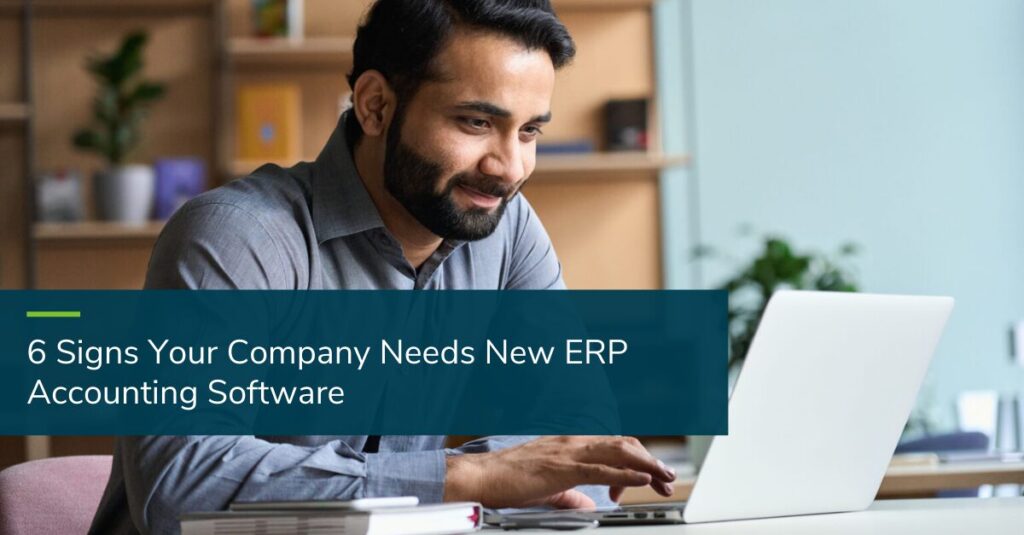
Your company is growing, and your small-business accounting software (hello, QuickBooks) or legacy ERP solution is no longer cutting it. But deciding when and if it’s time for a new system is difficult.
To help you decide if now is the right time to replace your current system, we’ll show you some of the signs that it’s time to upgrade, why ERP accounting software is better than QuickBooks and how to go about selecting the right system for your business.
Download Now
Who Wins: Standalone Accounting Systems or Comprehensive Cloud ERP Solutions?
Skip ahead if you know what you’re looking for:
- What is ERP Software?
- Signs Your Company Needs a New ERP
- Why is ERP Better than QuickBooks?
- Real-Life QuickBooks to ERP Success Story
- How to Select the Right ERP
What Is ERP Accounting Software?
Enterprise Resource Planning (ERP) works by combining all data, departments and processes into a single system. The result is streamlined operations and real-time insight into company-wide data.
How Does ERP Software Work?
An ERP solution operates using financial and accounting data as its foundation. All other modules – including inventory management, sales order management and embedded Customer Relationship Management (CRM) – are supplied with that financial data to carry out their jobs. Using this data to manage every aspect of your business allows you to perform more advanced processes, such as automated inventory reordering, by utilizing the most current and accurate information, like the availability of cash to spend on materials.
Signs Your Company Needs a New ERP
If you’re reading this blog, you’re likely dealing with some of the issues below. One of the most difficult parts of deciding if it’s time to upgrade your current software is answering the “Why now?” question. If any (or all!) of these signs sound familiar, it’s probably time to start thinking about what’s next for your company.
Sign #1: You’re Having Trouble Scaling Operations
Traditional accounting programs like QuickBooks or smaller ERP software require extensive add-ons or manual workarounds to manage higher volumes of transactions. This can lead to higher costs for you and can even limit company-wide growth.
Sign #2: You’re Dealing with Siloed Data
Back in 2021, Gartner reported that poor data quality costs organizations an average of $12.9 million. That’s big money. Data silos are often unknowingly created when businesses implement multiple separate systems to run different areas of their business. Silos occur when data collected by one of these applications cannot be accessed or used by other systems, limiting the visibility leaders need to make informed decisions.
Sign #3: You Don’t Trust Your Data
Human error happens, and when you’re using multiple software applications or manual processes to run your business, multiple data entry processes will undoubtedly create inaccuracies and make it hard for decision-makers to make good decisions. Here’s an example: a manufacturing company relying on QuickBooks for accounting doesn’t have an integrated system in place to manage inventory. Instead, it uses manual spreadsheets or piece-meal solutions to track material reordering, materials on hand and production scheduling. Because none of the company’s tools for managing inventory, accounting, warehousing and more integrate with each other, users are forced to enter data multiple times into different systems, creating the potential for bad inaccurate data.
Sign #4: You Can’t Pull the Reports You Need
To make the best decisions for your company, you need access to the data that matters most to your business. Traditional accounting systems are limited in reporting size and scope. DAS Medical (check out their customer success story below) was utilizing QuickBooks for its accounting. The company struggled to get the reports they needed, however. After implementing Acumatica ERP, DAS Medical gained quick access to the metrics and analytics that help it make strategic and timely business decisions – from cash flow prediction to inventory stocking to manufacturing planning.
Sign #5: You’re Running into Storage Limits
Many accounting systems limit the amount of data or records you can store at any given time, which forces companies to purchase additional storage or be highly selective about the data they keep.
Sign #6: Your Team is Spending Too Much Time on Workarounds
If your team is spending more time on manual tasks and workarounds than on actual production, you could be losing big money. Legacy ERP solutions or accounting-only systems require third-party adaptations, add-ons or software coding to work the way you want them to. This takes time and resources that could be spent on value-added tasks.
Why ERP is Better than QuickBooks (and Other Accounting-Only Solutions)
The biggest difference between the two solutions is ERP’s ability to manage all aspects of a business. While accounting software is great at managing a company’s financial data, ERP software includes functionality like warehousing or project management, key operational aspects of many businesses. These additional features make it possible for the information from those operations to flow into the ERP’s accounting module, giving leaders full control and visibility into how their business is running.
On top of this, ERP accounting software:
- Is often built with industry-specific capabilities to address industry-specific challenges.
- Is flexible and scalable, so as your business grows in size and complexity, your system does too.
- Comes equipped with role-based dashboards, pre-built reports and advanced analytics features to give you access to the business metrics you need.
What is Cloud ERP?
Many companies come to us looking to upgrade their proprietary or legacy ERP software. That’s because even though their current system may have at one point been enough to manage their operations, software becomes outdated fast. Cloud ERP, on the other hand, is maintained and updated by the software provider and includes the most up-to-date functionality and features available.
Nowadays, cloud ERP is the most popular deployment method for reasons including lower upfront costs, easier integration, better data security and greater scalability. The software is hosted in the cloud and then delivered via the internet as a subscription service.
The benefits of cloud ERP include:
- Superior data safety since cloud providers invest in world-class security measures and have teams of security experts on hand.
- Increased scalability and flexibility because there are fewer hardware or software limitations.
- Lower upfront costs as there is no need for a significant investment in hardware or software licenses.
- Greater collaboration and accessibility because workers can access the site from anywhere, at any time.
Real-Life QuickBooks to ERP Success Story
DAS Medical (we mentioned them above) produces single-use drapes and surgical equipment covers for hospitals and medical facilities throughout North America. It is headquartered in Atlanta, GA, and has manufacturing facilities in the Dominican Republic. Back in 2012 when the company was founded, it implemented QuickBooks for accounting but quickly outgrew the system as it experienced rapid and significant growth.

The team at DAS Medical knew it was time for an ERP solution that could support its manufacturing, inventory control and Material Requirements Planning (MRP) requirements. It enlisted NexTec’s consultants to help with the ERP selection and implementation process and ultimately decided on Acumatica’s cloud ERP system. Since going live and upgrading to its new ERP solution, DAS Medical has been able to:
- Report on production data 50% faster than before.
- Increase the number of users utilizing the software.
- Keep stock at optimal levels.
- Substantially grow production volumes without increasing overhead.
- Ensure superior compliance management with robust financial controls and audit trails.
Download Now
The Ultimate Guide to Choosing an ERP Implementation Partner
I’m Ready. How Do I Choose a New ERP System?
Congrats! You’re ready to start the ERP selection process. Try not to get overwhelmed; the ERP market is filled with solutions that may seem similar on the surface but are actually very different in terms of their capabilities, support structure, licensing models and feature sets. Choosing the right solution for your business is a critical part of ensuring success.
Here’s some of the steps to take in selecting an ERP for your company:
Step 1: Assemble a Project Team
Start by establishing an internal selection team, ideally including key stakeholders who will be using the software every day. The team should be able to articulate the features, functions and other requirements that are needed for your company.
Step 2: Conduct a Needs Assessment
Identify the areas of your operations that would benefit from ERP software. Put together a formal needs assessment that determines the features and functionality required and long-term objectives of your business. This exercise should include an evaluation of your current tools and technology that may be eliminated after implementing a full-scale ERP solution.
Step 3: Research and Put Together a Solution Short-List
Researching the various ERP solutions on the market and how they compare. An implementation partner like NexTec can help you get started. Use the needs assessment from the previous stage to determine a set of criteria for evaluating ERP vendors. Criteria should include things like price, industry experience and overall fit. An extensive list of requirements and desired features organized by level of importance will also be helpful.
Step 4: Select!
Once comparisons are made and results are analyzed, you should have a good picture of which ERP solution and implementation partner best matches your requirements. Don’t forget to ask for references and ensure that your preferred vendor has a solid plan for post-implementation support.
Feeling overwhelmed? That’s why Value-Added Resellers (like us!) are here. We help companies like you select, implement and utilize their software to its fullest potential.
Conclusion
Knowing when to upgrade to a new ERP accounting software system and what to upgrade to is complicated. But as your business grows, it’s critical that you have the tools in place to harness that growth, not hinder it. Be mindful of the signs it’s time you need a new ERP and if your company is struggling to stay productive, a new system may be in your future.
